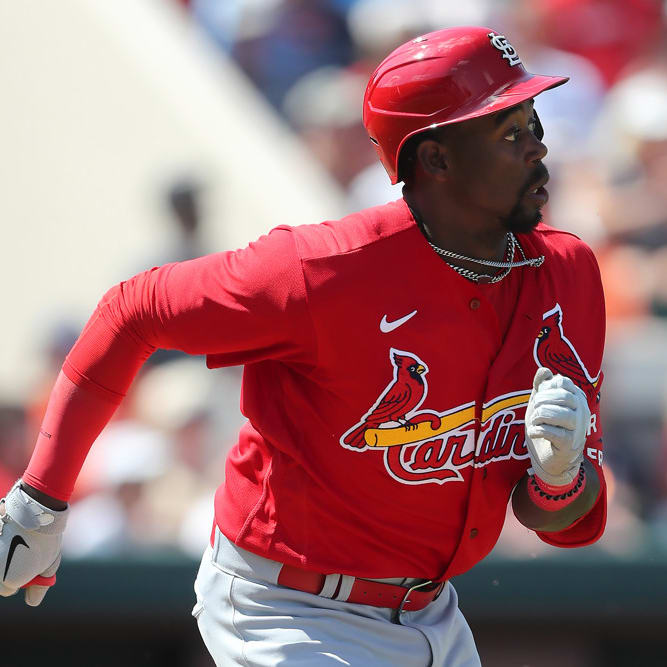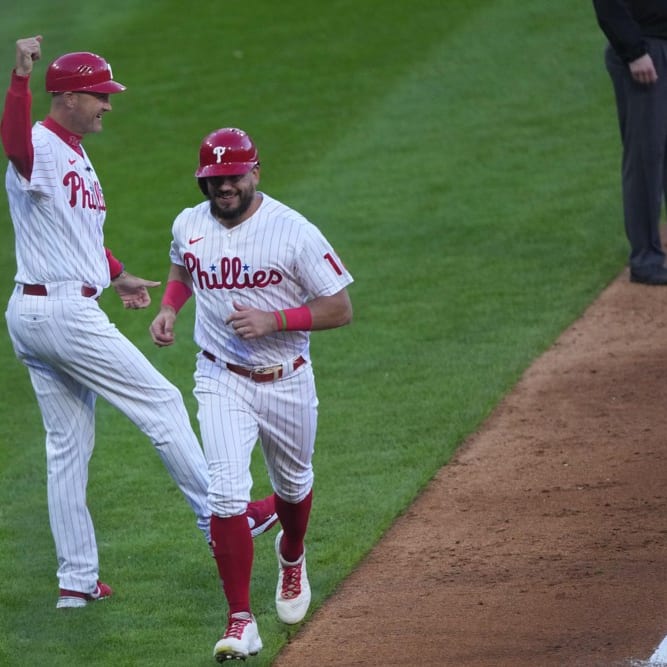This article is part of our The Saber's Edge series.
Every season, headlines surface about a pitcher gaining or losing fastball velocity. While most of these news stories happen right during spring training or at the beginning of the regular season, a pitcher can see midseason drops in velocity, especially when they come back from an injury. When a velocity loss is noticed, the key is to account for it appropriately and make an educated adjustment of the pitcher's value. This week, I will walk through this process by adjusting expectations for Mat Latos.
Latos missed the season's first half after having bone chips removed from his shoulder, and knee surgery. Since returning, his fastball velocity is down to an average of 90.4 mph compared to 92.6 mph in 2013. A 2.2 mph drop may seem significant, but is it really? On average, pitchers will continuously see a velocity decline as they age. Bill Petti and I looked at pitcher aging curves a few years back and found that pitchers maintain a relatively constant velocity until their age-26 season. After that point, it declines regularly. Since all pitchers will eventually see their velocity drop, I like to see the decline happen in smaller intervals so the pitcher can adjust more gradually.
The average velocity decline is 0.3 mph per season. Some pitchers will see more of a drop, while others may experience a velocity increase. A loss of a full mph is a red flag for me.
For an example, here are the starters who saw a drop between
Every season, headlines surface about a pitcher gaining or losing fastball velocity. While most of these news stories happen right during spring training or at the beginning of the regular season, a pitcher can see midseason drops in velocity, especially when they come back from an injury. When a velocity loss is noticed, the key is to account for it appropriately and make an educated adjustment of the pitcher's value. This week, I will walk through this process by adjusting expectations for Mat Latos.
Latos missed the season's first half after having bone chips removed from his shoulder, and knee surgery. Since returning, his fastball velocity is down to an average of 90.4 mph compared to 92.6 mph in 2013. A 2.2 mph drop may seem significant, but is it really? On average, pitchers will continuously see a velocity decline as they age. Bill Petti and I looked at pitcher aging curves a few years back and found that pitchers maintain a relatively constant velocity until their age-26 season. After that point, it declines regularly. Since all pitchers will eventually see their velocity drop, I like to see the decline happen in smaller intervals so the pitcher can adjust more gradually.
The average velocity decline is 0.3 mph per season. Some pitchers will see more of a drop, while others may experience a velocity increase. A loss of a full mph is a red flag for me.
For an example, here are the starters who saw a drop between 0.5-0.9 mph, and those with a drop greater than 1.0 mph from 2013 to 2014 (min 10 IP each season).
-0.5 mph to -0.9 mph: Gerrit Cole, Chris Archer, Max Scherzer, Gio Gonzalez, Yu Darvish, James Paxton, Jason Vargas, Francisco Liriano, Matt Garza, Tim Hudson, Nathan Eovaldi, Hisashi Iwakuma, Kevin Correia, Mark Buehrle, Jake Peavy, Jon Lester, Jarred Cosart, Justin Verlander, Stephen Strasburg, Kyle Gibson, Bartolo Colon, Adam Wainwright, Taijuan Walker
-1.0 mph or more: A.J. Burnett, Anibal Sanchez, Wandy Rodriguez, Chris Tillman, John Danks, Cliff Lee, Ubaldo Jimenez, Scott Feldman, Julio Teheran, Scott Kazmir, Mike Pelfrey, Charlie Morton, Jon Niese, Jhoulys Chacin, Bronson Arroyo, Matt Harrison, Dan Straily, Danny Salazar, Mat Latos, CC Sabathia, Erik Johnson, Martin Perez, Taylor Jordan
Struggling and/or hurt pitchers are more common in the second list. Again, velocity loss is inevitable so don't be surprised to see it decline for any pitcher.
Two keys need to be taken into account when comparing velocities from one season to the next.
The first key is to note if the pitcher is moving from being a starter to a reliever, or vice versa. On average, a starter will see a 1.0 mph increase in velocity when they move to being a reliever and vice versa when going the over way. For example, Tyson Ross' velocity is down 1.4 mph from last season. Last season, he started in only 16 of the 35 games he appeared. He was able to throw harder in those relief appearances than as a full-time starter this season. Pitchers making this transition are the toughest to gauge with velocity loss because it impossible to know if a velocity drop is the result of the role change, or from age/injury decline.
The second item to look at is the percent usage of different fastball types. I used the BIS velocity values at FanGraphs which include all fastballs (two-seam, four-seam, cutter). If a pitcher has changed his mix, it may look like his velocity has declined. The best place to get pitch data is Brooksbaseball.net. They reclassify all the pitches and adjust velocities depending of the stadium's radar gun. Most of the time checking doesn't make a difference, but sometimes it does.
Scott Kazmir falls into the group of pitchers which could see a huge production drop or may be injured because of his 1.3 mph drop in velocity. Going to his Brooksbaseball.net page, my worries are lessened. Here are his 2013 and 2014 velocities and usage percentages for his four-seamer and sinker (two-seamer).
Four-Seamer
2013: 93.6, 37%
2014: 93.7, 26%
Sinker (Two-Seamer)
2013: 92.8, 27%
2014: 92.4, 27%
His velocity decline is not as bad as it seems. The velocity is down with both pitches, but it is less than 1.0 mph. Also, the usage of his faster four-seamer is down, which lessens his over velocity drop.
Moving on to predict his new talent level, a pitcher's strikeout rate declines with his velocity. Here are Latos' velocity values and K% since he became a regular starter.
Season: FB velo, K%
2010: 93.7, 25%
2011: 92.8, 23%
2012: 92.6, 22%
2013: 92.6, 21%
2014: 90.4, 16%
His strikeout right has fallen with his velocity. Looking at the fastball velocity and K% change for all starting pitcher paired seasons from 2002 to 2014, I found for every 1.0 mph decline (or increase) in velocity, a starting pitcher should expect on average a 1.1% point drop (or increase) in K% (1.9% point drop for relievers). If we only knew that Latos' projected K% was 21% K% (factoring in aging), and he was throwing 90.4 mph in his rehab starts, a change in talent should lead the projected K% to ~18%.
While it may seem irrational to base a talent change on just a reportedly lower velocity, it is a sound method. A fastball speed stabilizes in one pitch. Just one fastball will get us to 50% of the player's talent level. Additionally, I looked at pitchers coming back from the DL and found they rarely improved their velocity by more than 1.0 mph. If a fantasy owner wants to jump the gun on an extremely small sample, use velocity.
Additionally, as a player's K% declines, their ERA will increase. Mike Fast looked at these values a while back and found that for every 1.0 mph decrease in fastball velocity a starter should expect to gain .28 to his ERA and reliever will see a .45 increase. Right now Latos is bucking the trend with his 3.31 ERA which is suppressed by a career-low HR/9 (0.5) and BABIP (.206).
Pulling it all together, here is a simple step-by-step procedure for dealing with velocity change.
1. Fastball velocity changes can be taken seriously with a minuscule sample size.
2. All pitchers will lose velocity. Be concerned if a pitcher sees a decline of more than 1.0 mph.
3. A 1.0 mph drop in velocity means a 1.1% drop in K% for starters and a 1.9% decline for relievers.
4. A 1.0 mph drop in velocity means a 0.28 point increase in ERA for starters and 0.45 increase for relievers.
5. When looking at velocity changes, make sure to check if the pitcher is moving from one role to another. Also, make sure their fastball pitch mix hasn't changed.
I have seen fantasy owners understate and overstate the importance of a velocity change. Some will see Tyler Skaggs' 3.0 mph jump and are ready to crown him the next Felix Hernandez. Others will point to Mat Latos' 2.0 mph drop and say he's fine since his ERA is still low. There is a happy medium.
Hopefully, you now have a better understanding of how to deal with a fastball velocity change. Let me know if you have any questions.










